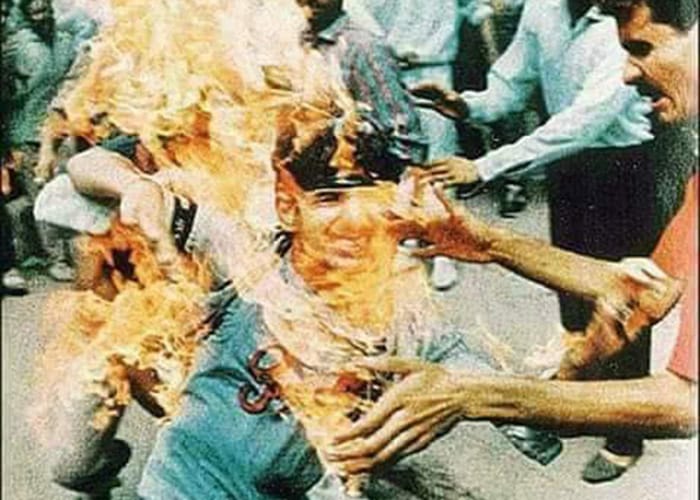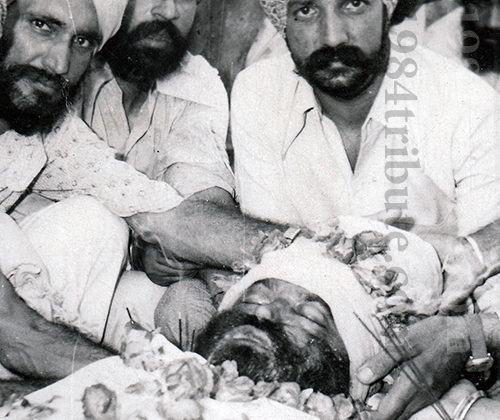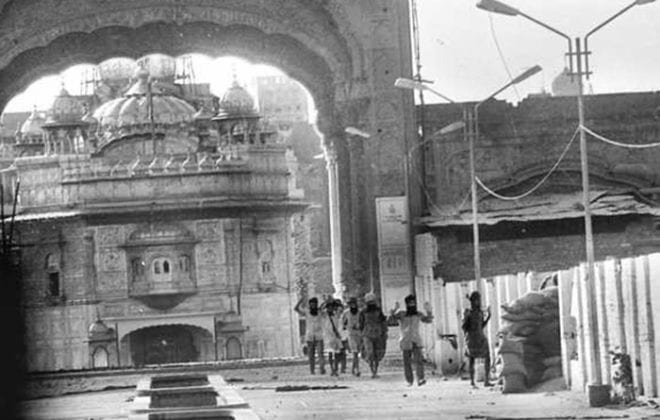1984 November – The Sikh Genocide
1984 November – The Sikh Genocide
Following the attack on June 1st 1984 on Sri Harmandir Sahib (also referred to as Golden Temple), the damage done to Sikh minds and hearts was severe and irreparable. Thousands of Sikhs across the world protested and demonstrated against the attack on the holiest shrine and highest temporal authority of the Sikhs. Sikhs went from disbelief and shock, quickly to grief and anger, as it dawned on them that it was not a foreign power, but instead their own government which carried out the atrocities. The waves of extrajudicial killings of Sikhs across Punjab, along with other grave human rights abuses committed against Sikh women, could not be tolerated.
Although thousands protested worldwide, no International Aid came for the Sikhs. All foreign media and Human Rights groups were expelled from Punjab, and military rule was imposed. Those guilty of mass murder did not face justice (in fact in the face of thousands of pages of evidence compiled by Independent Human Rights organisations, a member of the security services has yet to be prosecuted. Sikh complaints and pleas went unheard. The Army became the Judge the Jury and Executioner in Punjab, and thousands of innocent Sikhs were tortured and killed. When the order for the atrocities was given by the then Prime Minister Indira Gandhi, who could one turn to for redress.
Bhai Satwant Singh and Beant Singh two personal bodyguards of the Indian Prime Minister held Indira responsible for the war crimes committed against Sikhs (which were still committed post Operation Blue Star).
In realisation that all other democratic means to restore justice had been exhausted, or would never be available to Sikhs, they assassinated her on 31st October 1984. After assassinating Indira Gandhi, although all her other armed guards had run off, the two Sikhs did not wish to harm anyone else or escape. They laid down their weapons, content to accept full responsibility for their actions. Whilst Beant Singh was illegally shot and murdered on the spot, Satwant Singh who was also shot, survived, and was later hanged with Kehar Singh (found guilty of conspiracy to murder, when there was never any evidence against him) for the assassination of Indira Gandhi.
The events that took place after shocked the civilised world. Although the two responsible for the assassination voluntarily courted arrest, and were either shot dead or hanged, the new Prime Minister, Rajiv Gandhi (son of Indira) reacted by launching a State organised campaign of death against as many Sikhs as possible. All Sikh men were singled out by Congress led fundamentalist Hindu mobs across Northern India, and were either bludgeoned to death with iron bars, or doused with kerosene and burnt alive. Sikh women were stripped naked and gang raped in front of their children, some being killed whilst others fled humiliated and naked. Sikh businesses, houses, and vehicles were set on fire. 10,000 Sikhs lost their lives in three days, and over 50,000 became permanently homeless.
Delhi ‘Riots’
Almost immediately the Indian government attempted to suppress the evidence of the genocide, to deny the extent of the violence and their role in it.
The genocide was quickly described as a communal riot, although only Sikhs were attacked. Wrongly referred to as the Delhi Riots, the violence wasn’t just confined to Delhi, but unleashed throughout India. Sikhs were killed in Uttar Pradesh, Bihar, Madhya Pradesh (nearly 40 towns), Haryana, West Bengal, Himachal Pradesh, Assam, Maharashtra, Rajasthan and Gujarat.
Genocide is defined by the United Nations as ‘any of the following acts committed with the intent to destroy, in whole or in part, a national, ethnical, racial or religious group – Killing members of the group; Causing serious bodily or mental harm to members of the group; Deliberately inflicting on the group conditions of life calculated to bring about its physical destruction in whole or in part.’
UN CONVENTION ON GENOCIDE – ARTICLE TWO
The infamous 1992 Los Angeles Riots were sparked on April 29, 1992, when a jury acquitted four Los Angeles Police Department officers accused in the videotaped beating of black motorist Rodney King. Thousands of people in the Los Angeles area rioted over the six days following the verdict, as well as in other locations in the United States and Canada. Property damages topped roughly US$1 billion. In all, 53 people died during the riots.
In the 1984 “riots” in India over 10,000 Sikhs were massacred in less than three days. To distinguish the two events, a riot is a noisy, violent public disorder caused by a group or crowd. It is disorganised and chaotic outbursts of violence, committed by different groups, and commonly against the State. The mass killings of Sikhs across northern Indian States, was pre-planned, organised and carried out by members of the Indian government and its supporters, with full collusion (consent/involvement) of the Indian army and police:
“The attack on Sikhs and their property in our locality appeared to be an extremely organized affair…There were also some young men on motorcycles, who were instructing the mobs and supplying them with kerosene oil from time to time.”
Aseem Shrivastava (eyewitness), a Masters student at the Delhi School of Economics
Further evidence that the “carnage was orchestrated by the ruling party” (Truth about Delhi Violence (1985), Citizens for Democracy), was the broadcasting of provocative slogans seeking bloody vengeance, ‘khoon ka badla khoon se lenge’ (we will take blood for blood!) and “Sardar qaum ke ghaddar” (Sikhs are traitors to India) by State controlled television station Doordarshan, and All India Radio.
“The attacks on members of the Sikh Community in Delhi and its suburbs during the period, far from being a spontaneous expression of “madness” and of popular “grief and anger” at Mrs. Gandhi’s assassination as made out to be by the authorities, were the outcome of a well organisedplan marked by acts of both deliberate commissions and omissions by important politicians of the Congress (I) at the top and by authorities in the administration.”
Who are the Guilty?, People’s Union for Civil Liberties (Indian Human Rights Group)
Involvement of the Police
The police took all measures to maximise the killing efficiency of the mobs. On the morning of 1 November, mobs led by local Congress (I) leader, Dr Ashok Gupta, descended on Block 11 of Kalyanpuri. However, these Sikhs were Sikligar Sikhs and have a rich martial tradition, as they were entrusted by Guru Gobind Singh ji with the responsibility of making weapons for the Sikh armies.
Thus, despite their extreme poverty many owned licensed firearms, and greeted the mobs with gunfire forcing the mob to retreat. Within minutes though, the police arrived. Accompanied by armed constables, the Chief of Kalyanpuri police, Soor Veer Singh Tyagi, read out a list of licensed weapon holders. Tyagi ordered all the Sikhs to surrender their weapons at gunpoint. 25 of the Sikhs were also arrested and sent to Tihar jail registering cases of rioting AGAINST them.
These arrests were the only ones to figure in the police records of arrests on the first day of the massacre. After seizing licensed weapons, the police left the Sikhs of Block 11 at the mercy of the mobs waiting outside. None of the police officers of Kalyanpuri, which covered Trilokpuri were ever brought to book, despite evidence from victims and journalists. Soor Veer Singh Tyagi, Station House Officer and Deputy Commissioner of Police, Sewa Dass went onto numerous promotions in their careers.
“Such wide-scale violence cannot take place without police help. Delhi Police, whose paramount duty was to upkeep law and order situation and protect innocent lives, gave full help to rioters who were in fact Congress Workers or else mercenaries hired by the Indian National Congress… It is a known fact that many jails, sub-jails and lock-ups were opened for three days and prisoners, for the most part hardened criminals, were provided fullest provisions, means and instruction to “teach the Sikhs a lesson”. But it will be wrong to say that Delhi Police did nothing, for it took full and keen action against Sikhs who tried to defend themselves.”
The Tribune (Indian Newspaper)
Attack on the Guru
One of the tenets of the Sikh religion, is the fundamental belief that Siri Guru Granth Sahib ji, is the living Guru for the Sikhs. Sikhs believe the divine light of God was bestowed on Guru Nanak Dev Ji in 1469. He in turn imparted the light to Bhai Lehna ji who then became Guru Angad Dev Ji. In this way the divine light has been conferred to all ten Gurus. Although the divine light remained the same, the bodies of the Gurus changed. On 30th October 1708 the tenth Guru passed on the divine light to the Shabad Guru that we revere in its embodiment, the Guru Granth Sahib Ji.
Nothing is more sacred, and revered to a Sikh then his beloved Guru (apunay satgur kai balihaarai,I am a sacrifice to my True Guru- SSGSJ). Similarly, nothing is more distressing or painful than an attack (physical or otherwise) on Siri Guru Granth sahib ji.
During the anti-Sikh pogroms hundreds of Gurdwaras were attacked, burnt and saroops of the Guru Granth sahib ji were set alight by the mobs. Over 130 Gurdwaras were attacked in Delhi alone. One such Gurdwara was Rakab Ganj Gurdwara. This historic Gurdwara marks the spot where Guru Tegh Bahadur, the 9th Sikh guru was cremated after being executed in Delhi on the orders of the then Mughal emperor, Aurangzeb in 1675.
A sacrifice without parallel in the history of religious persecution, Guruji was killed for defending the religious freedom of people belonging to a different faith. The Hindu Pandits of Kashmir were being forcibly converted into Islam, and the Sikh guru decided to defend their freedom of worship.
This sacrifice was however lost on the Hindu mob attacking the temple on 1 November 1984. Two Sikhs were burnt alive while the rioters made repeated attempts to burn the Gurudwara. All was being overseen by Kamal Nath (Member of Parliament (Lok Sabha):
“Outside the Gurdwara I saw a crowd of about 4,000 men led by Congress-I leader Kamal Nath… I saw the bodies of two men, both Sikhs, still burning on the roadside”. Senior Journalist Sanjay Suri in his affidavit before Mishra Commission.
In spite of evidence, of Kamal Nath’s involvement including his own admission of being there at the scene, he has not been prosecuted for his crimes. Having escaped justice, one would have thought Kamal Nath would be leading a quiet life, instead he is a senior member of the Indian National Congress party, and currently the Union Minister of Road, Transport & Highways.
2ndNovember – Massacre in Trilokpuri
Even after 26 years, Human Rights Groups are still uncovering new evidence of violence committed, to add to the thousands of such instances over the three days. Therefore it is impossible to attempt to summarise or reduce the violent atrocities that were committed in those dark days, to a few pages.
However, the immediate aftermath of the massacre in Trilokpuri, as witnessed by Independent journalists opens a small window into the state-sponsored terrorism that was unleashed on the unsuspecting Sikhs in Delhi and surrounding states.
The casual slaughter of at least400 Sikhs (official count), including women and children in the trans-Yamuna Trilokpuri resettlement colony, has become the largest ever massacre in a single residential block in any city in post-Independence India.
If it was not for three journalists of the Indian Expressand Jansatta,the sheer horror of what transpired would have been confined to the 500 square yard block, in which according to the Nanavati Commission “almost all Sikh males were killed”.
Due to the complicity of the Police and State, the mobs had so much control they were able to take a break from killing hundreds of Sikhs, and return an hour later having eaten to continue the massacre and kill any remaining Sikhs.
According to Rahul Bedi one of the journalists, having witnessed the aftermath of the 48 hour massacre, the images:
“over two decades later, still haunt my memories”
“Both lanes were littered with bodies with body parts and hair brutally hacked off, forcing people to walk on tiptoe. It was impossible to place one’s foot fully on the ground for one would step on either a hacked limb or a dead person.
The entire area was awash with blood, some liquid, some clotted. Blood-gorged flies buzzed lazily, sated. The blood did not flow down the drains, as they too were now choked with human body parts.”
“In the 25 years since then, we eyewitnesses deposed before innumerable inquiry commissions, culminating with the one headed by Justice Nanavati. However, not one of those really guilty ever ended up being punished for the state-sanctioned pogrom of 1984.”
Whilst all Sikh males were singled out in a genocidal campaign, Sikh women were not spared. The treatment of Sikh women during the three days of violence is abhorrent and heart wrenching.
Gurdip Kaur, who lost her three sons and her husband, described the attack.
“Three of the men (husband and 2 sons) ran out and were set on fire. My youngest son stayed in the house with me. But they came into the house, maybe eight of them. They tore my clothes and stripped me naked in front of my son. My son pleaded with them “Brothers, please don’t do this. She is your mother just as she is my mother. They repeatedly raped me right there, in front of my son, in my own house. After they had taken my honour, they left. I took my son to sit among the women but they came and dragged him away. They took him to the street corner, hit him with lathis, poured kerosene over him, and burnt him alive.”
Those that survived are not considered lucky. From 10 November, the government anxious to proclaim that ‘normalcy has been restored’, – with brutal cold heartedness closed the refugee camps, and forcibly sent the refugees back to the blood soaked and charred colonies from which they had fled. In which they had seen their relatives being hacked and burnt just a week earlier. They were given 50 rupees (less than £1) a piece plus some dry rations and herded into buses.
Without any care, support, or counselling thesmall children (many orphaned) developed serious psychological conditions having witnessed the brutal killings of their families. Sikh widows are still struggling for justice; hoping one day the killers of their families will be held accountable.
The first words of Rajiv Gandhi in 1984 as the Prime Minister of India, in his first statement regarding the anti-Sikh violence sealed the fate of those expecting justice; he remarked “when a big tree falls, it is only natural for the ground to shake a little“. He considered the thousands of killings of Sikhs in the aftermath of the killing of Indira Gandhi, a natural reaction. He did not condemn the barbaric actions of the mobs or make any declaration that the government would prosecute those guilty.
After 10 commissions in over 26 years NGO Human Rights Watchconcludes the outcome:
“Despite numerous credible eye-witness accounts that identified many of those involved in the violence, including police and politicians, in the months following the killings, the government sought no prosecutions or indictments of any persons, including officials, accused in any case of murder, rape or arson.”
Chu kar az hama heelte dargujasht Halal ast burdan ba shamshir dast
(“When all other means have failed, it is just to take to the sword.”)
Guru Gobind Singh ji
In Operation Bluestar thousands of Sikhs were killed in and around Punjab, following the storming of Siri Harmandir Sahib. Sadly many Sikhs today are content with the poor and illogical justifications given by the Indian government of Sikh separatists being the reason of such bloodshed. That for an alleged handful of militants the Indian army was required to attack the Sikhs holiest shrine with battle tanks.
In contrast, there was no such excuse or attempt at justification for the anti-Sikh pogroms. The Sikhs in Delhi supported and voted for the Congress government, but in the end all Sikhs were considered enemies, and even great Sikh war heroes, who fought for the freedom of India were targeted.
It was in this context that Sikh freedom fighting paramilitary groups began to target those guilty of mass murder against the Sikhs. Similar to the Nazi Hunters (Israeli secret service who assassinated Nazi war criminals hiding across the globe), a list was drawn up of those responsible according to eye witnesses, and assassinations were carried out.


